roof MERCEDES-BENZ METRIS 2020 MY20 Operator’s Manual
[x] Cancel search | Manufacturer: MERCEDES-BENZ, Model Year: 2020, Model line: METRIS, Model: MERCEDES-BENZ METRIS 2020Pages: 320, PDF Size: 26.38 MB
Page 8 of 320
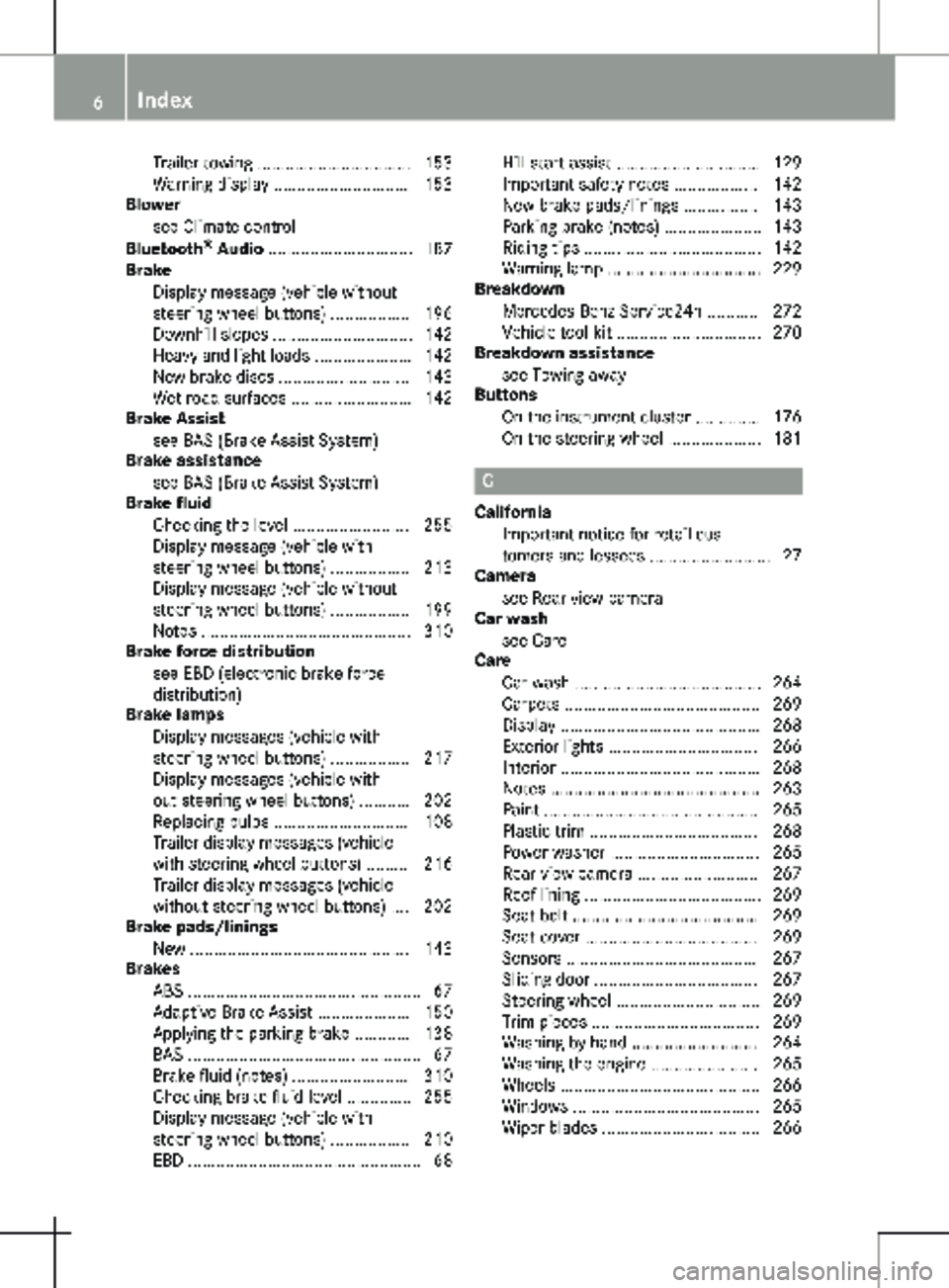
Trailer towing ................................. 153
Warning display
............................. 153
Blower
see Climate control
Bluetooth ®
Audio ............................... 187
Brake
Display message (vehicle without
steering wheel buttons) ................. 196
Downhill slopes .............................. 142
Heavy and light loads ..................... 142
New brake discs ............................ 143
Wet road surfaces .......................... 142
Brake Assist
see BAS (Brake Assist System)
Brake assistance
see BAS (Brake Assist System)
Brake fluid
Checking the level ......................... 255
Display message (vehicle with
steering wheel buttons) ................. 213
Display message (vehicle without
steering wheel buttons) ................. 199
Notes ............................................. 310
Brake force distribution
see EBD (electronic brake force
distribution)
Brake lamps
Display messages (vehicle with
steering wheel buttons) ................. 217
Display messages (vehicle with-
out steering wheel buttons) ........... 202
Replacing bulbs ............................. 108
Trailer display messages (vehicle
with steering wheel buttons) ......... 216
Trailer display messages (vehicle
without steering wheel buttons) .... 202
Brake pads/linings
New ............................................... 143
Brakes
ABS .................................................. 67
Adaptive Brake Assist .................... 150
Applying the parking brake ............ 138
BAS .................................................. 67
Brake fluid (notes) ......................... 310
Checking brake fluid level .............. 255
Display message (vehicle with
steering wheel buttons) ................. 210
EBD .................................................. 68 Hill start assist ............................... 129
Important safety notes
.................. 142
New brake pads/linings ................ 143
Parking brake (notes) ..................... 143
Riding tips ...................................... 142
Warning lamp ................................. 229
Breakdown
Mercedes-Benz Service24h ........... 272
Vehicle tool kit ............................... 270
Breakdown assistance
see Towing away
Buttons
On the instrument cluster .............. 176
On the steering wheel .................... 181 C
California Important notice for retail cus-
tomers and lessees ..........................
27
Camera
see Rear view camera
Car wash
see Care
Care
Car wash ........................................ 264
Carpets .......................................... 269
Display ........................................... 268
Exterior lights ................................ 266
Interior ........................................... 268
Notes ............................................. 263
Paint .............................................. 265
Plastic trim .................................... 268
Power washer ................................ 265
Rear view camera .......................... 267
Roof lining ...................................... 269
Seat belt ........................................ 269
Seat cover ..................................... 269
Sensors ......................................... 267
Sliding door ................................... 267
Steering wheel ............................... 269
Trim pieces .................................... 269
Washing by hand ........................... 264
Washing the engine ....................... 265
Wheels ........................................... 266
Windows ........................................ 265
Wiper blades .................................. 266 6
Index
Page 9 of 320
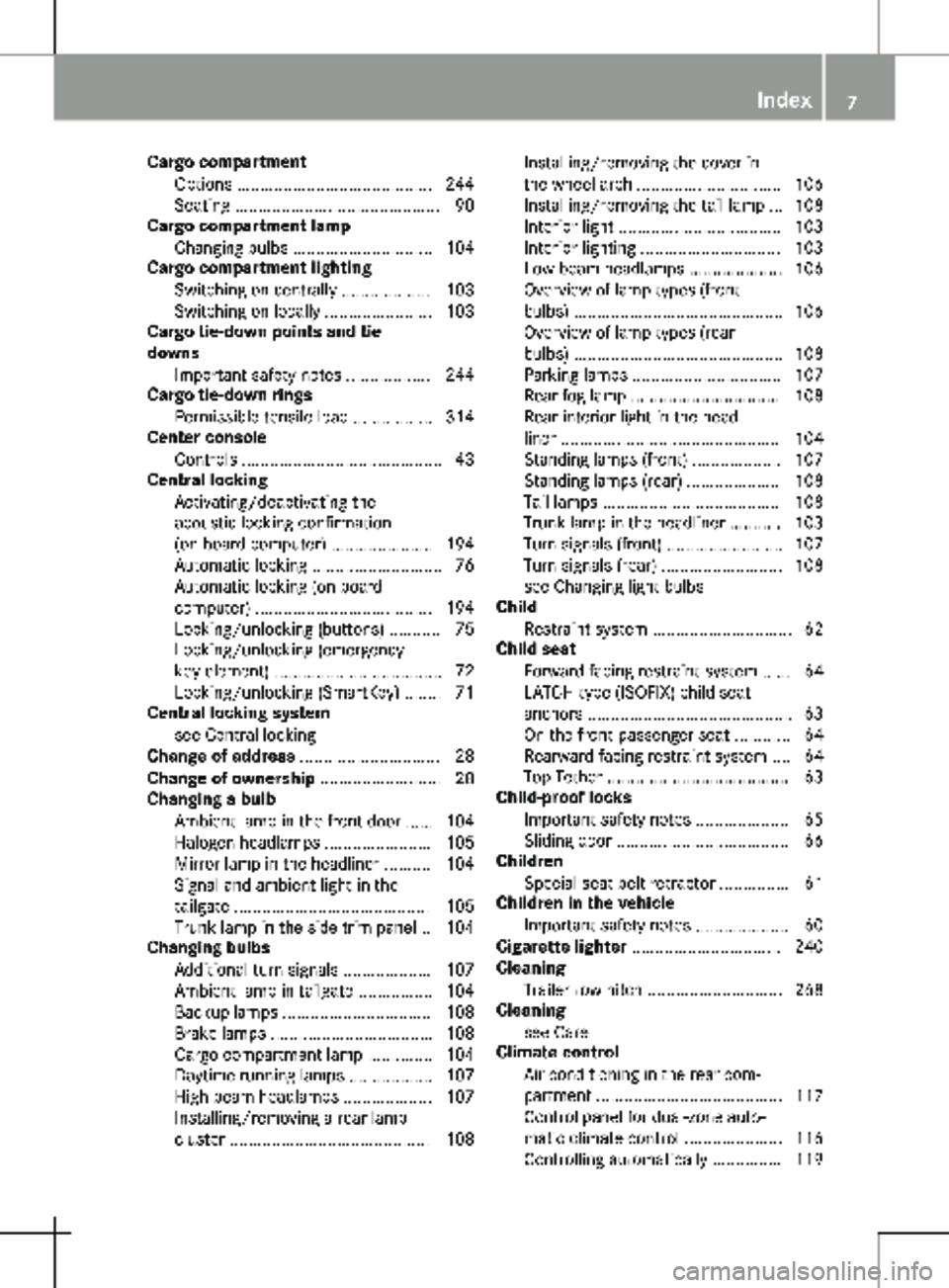
Cargo compartment
Options .......................................... 244
Seating ............................................ 90
Cargo compartment lamp
Changing bulbs .............................. 104
Cargo compartment lighting
Switching on centrally ................... 103
Switching on locally ....................... 103
Cargo tie-down points and tie
downs
Important safety notes .................. 244
Cargo tie-down rings
Permissible tensile load ................. 314
Center console
Controls ........................................... 43
Central locking
Activating/deactivating the
acoustic locking confirmation
(on-board computer) ...................... 194
Automatic locking ............................ 76
Automatic locking (on-board
computer) ...................................... 194
Locking/unlocking (buttons) ........... 75
Locking/unlocking (emergency
key element) .................................... 72
Locking/unlocking (SmartKey) ........ 71
Central locking system
see Central locking
Change of address .............................. 28
Change of ownership .......................... 28
Changing a bulb
Ambient lamp in the front door ...... 104
Halogen headlamps ....................... 105
Mirror lamp in the headliner .......... 104
Signal and ambient light in the
tailgate .......................................... 105
Trunk lamp in the side trim panel .. 104
Changing bulbs
Additional turn signals ................... 107
Ambient lamp in tailgate ................ 104
Backup lamps ................................ 108
Brake lamps ................................... 108
Cargo compartment lamp .............. 104
Daytime running lamps .................. 107
High-beam headlamps ................... 107
Installing/removing a rear lamp
cluster ........................................... 108 Installing/removing the cover in
the wheel arch
............................... 106
Installing/removing the tail lamp ... 108
Interior light ................................... 103
Interior lighting .............................. 103
Low-beam headlamps .................... 106
Overview of lamp types (front
bulbs) ............................................. 106
Overview of lamp types (rear
bulbs) ............................................. 108
Parking lamps ................................ 107
Rear fog lamp ................................ 108
Rear interior light in the head-
liner ............................................... 104
Standing lamps (front) ................... 107
Standing lamps (rear) .................... 108
Tail lamps ...................................... 108
Trunk lamp in the headliner ........... 103
Turn signals (front) ......................... 107
Turn signals (rear) .......................... 108
see Changing light bulbs
Child
Restraint system .............................. 62
Child seat
Forward-facing restraint system ...... 64
LATCH-type (ISOFIX) child seat
anchors ............................................ 63
On the front-passenger seat ............ 64
Rearward-facing restraint system .... 64
Top Tether ....................................... 63
Child-proof locks
Important safety notes .................... 65
Sliding door ..................................... 66
Children
Special seat belt retractor ............... 61
Children in the vehicle
Important safety notes .................... 60
Cigarette lighter ................................ 240
Cleaning
Trailer tow hitch ............................. 268
Cleaning
see Care
Climate control
Air conditioning in the rear com-
partment ........................................ 117
Control panel for dual-zone auto-
matic climate control ..................... 116
Controlling automatically ............... 119 Index
7
Page 21 of 320
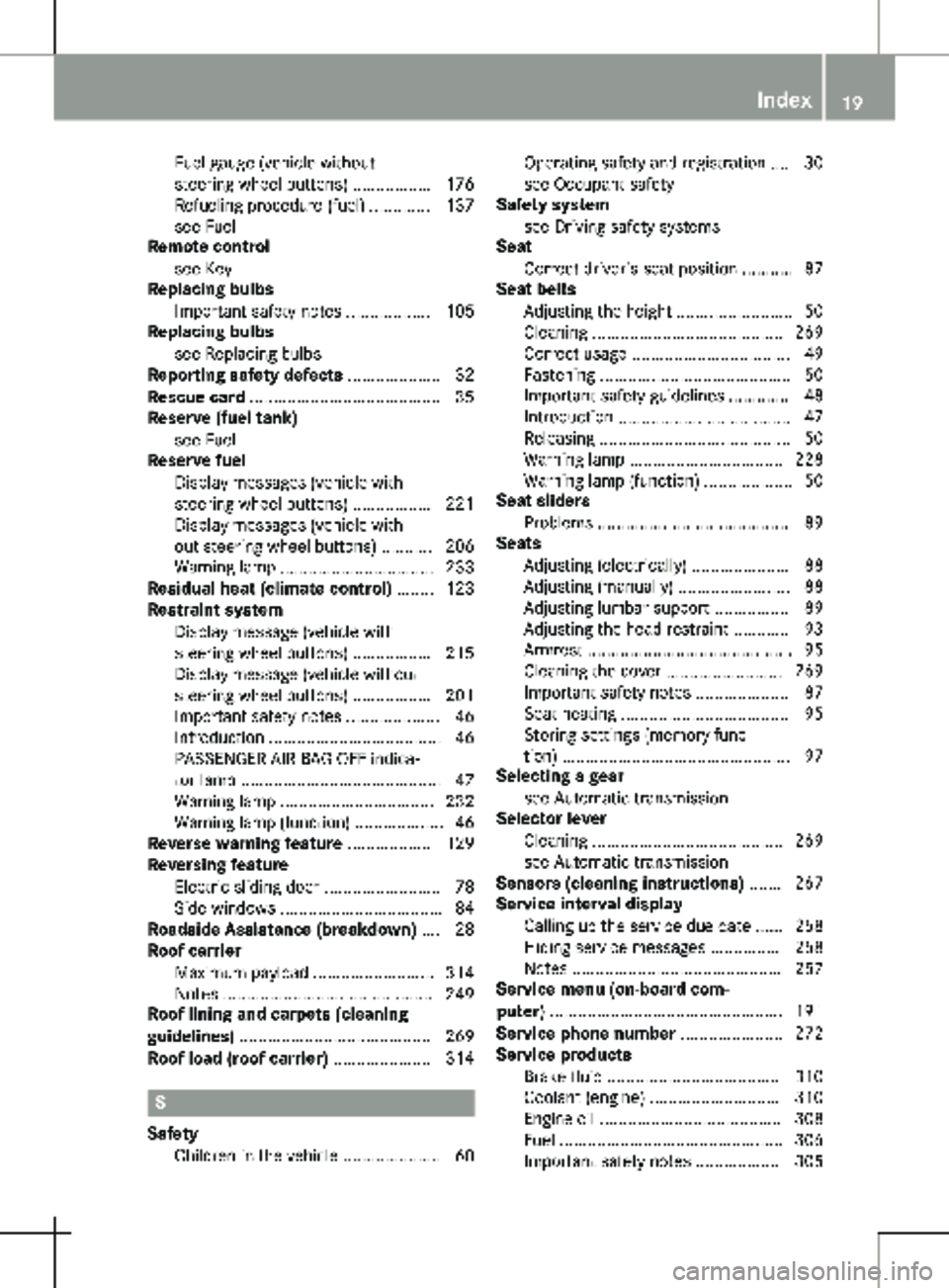
Fuel gauge (vehicle without
steering wheel buttons) .................
176
Refueling procedure (fuel) ............. 137
see Fuel
Remote control
see Key
Replacing bulbs
Important safety notes .................. 105
Replacing bulbs
see Replacing bulbs
Reporting safety defects .................... 32
Rescue card ......................................... 35
Reserve (fuel tank) see Fuel
Reserve fuel
Display messages (vehicle with
steering wheel buttons) ................. 221
Display messages (vehicle with-
out steering wheel buttons) ........... 206
Warning lamp ................................. 233
Residual heat (climate control) ........ 123
Restraint system
Display message (vehicle with
steering wheel buttons) ................. 215
Display message (vehicle without
steering wheel buttons) ................. 201
Important safety notes .................... 46
Introduction ..................................... 46
PASSENGER AIR BAG OFF indica-
tor lamp ........................................... 47
Warning lamp ................................. 232
Warning lamp (function) ................... 46
Reverse warning feature .................. 129
Reversing feature
Electric sliding door ......................... 78
Side windows ................................... 84
Roadside Assistance (breakdown) .... 28
Roof carrier
Maximum payload .......................... 314
Notes ............................................. 249
Roof lining and carpets (cleaning
guidelines) ......................................... 269
Roof load (roof carrier) ..................... 314S
Safety Children in the vehicle
..................... 60 Operating safety and registration .... 30
see Occupant safety
Safety system
see Driving safety systems
Seat
Correct driver's seat position ...........
87
Seat belts
Adjusting the height ......................... 50
Cleaning ......................................... 269
Correct usage .................................. 49
Fastening ......................................... 50
Important safety guidelines ............. 48
Introduction ..................................... 47
Releasing ......................................... 50
Warning lamp ................................. 228
Warning lamp (function) ................... 50
Seat sliders
Problems ......................................... 89
Seats
Adjusting (electrically) ..................... 88
Adjusting (manually) ........................ 88
Adjusting lumbar support ................ 89
Adjusting the head restraint ............ 93
Armrest ............................................ 95
Cleaning the cover ......................... 269
Important safety notes .................... 87
Seat heating .................................... 95
Storing settings (memory func-
tion) ................................................. 97
Selecting a gear
see Automatic transmission
Selector lever
Cleaning ......................................... 269
see Automatic transmission
Sensors (cleaning instructions) ....... 267
Service interval display
Calling up the service due date ...... 258
Hiding service messages ............... 258
Notes ............................................. 257
Service menu (on-board com-
puter) .................................................. 191
Service phone number ...................... 272
Service products
Brake fluid ..................................... 310
Coolant (engine) ............................ 310
Engine oil ....................................... 308
Fuel ................................................ 306
Important safety notes .................. 305 Index
19
Page 22 of 320

Refrigerant (air-conditioning sys-
tem) ............................................... 311
Transmission oil ............................. 310
Washer fluid ................................... 312
Setting a speed
see Cruise control
Setting the air distribution ............... 120
Setting the airflow ............................ 120
Settings
Factory (vehicle with steering
wheel buttons) ............................... 194
Factory (vehicle without steering
wheel buttons) ............................... 179
On-board computer (vehicle with
steering wheel buttons) ................. 191
On-board computer (vehicle with-
out steering wheel buttons) ........... 179
Side impact air bag ............................. 52
Side windows
Cleaning ......................................... 265
Convenience closing feature ............ 85
Convenience opening feature .......... 85
Hinged side windows ....................... 84
Important safety information ........... 84
Opening/closing .............................. 85
Overview .......................................... 84
Problem (malfunction) ..................... 86
Resetting ......................................... 86
Signal and ambient light
Changing a bulb ............................. 105
Sliding door
Child-proof locks .............................. 66
Cleaning ......................................... 267
Important safety notes .................... 77
Indicator lamp ................................ 237
Opening/closing from the inside ..... 77
Opening/closing from the out-
side .................................................. 77
see Electric sliding door
SmartKey
Changing the battery ....................... 73
Changing the programming ............. 72
Checking the battery ....................... 73
Convenience closing feature ... 85, 123
Convenience opening feature .......... 85
Door central locking/unlocking ....... 71
Important safety notes .................... 71
Loss ................................................. 74 Mechanical key ................................ 72
Problem (malfunction)
..................... 74
SmartKey positions (ignition
lock) .................................................... 127
Snow chains ...................................... 281
Sockets .............................................. 241
Spare wheel
General notes ................................ 302
Important safety notes .................. 302
Removing/mounting ...................... 303
Special seat belt retractor .................. 61
Specialist workshop ............................ 32
Speed, controlling
see Cruise control
Speedometer
Activating/deactivating the addi-
tional speedometer (vehicle with
steering wheel buttons) ................. 192
Activating/deactivating the addi-
tional speedometer (vehicle with-
out steering wheel buttons) ........... 180
Digital (vehicle with steering
wheel buttons) ............................... 185
Digital (vehicle without steering
wheel buttons) ............................... 178
General notes ................................ 175
In the instrument cluster (vehicle
with steering wheel buttons) ............ 40
In the instrument cluster (vehicle
without steering wheel buttons) ...... 38
Setting the display unit (vehicle
with steering wheel buttons) ......... 192
Setting the display unit (vehicle
without steering wheel buttons) .... 180
SRS (Supplemental Restraint Sys-
tem)
see Restraint system
Standing lamp
Display messages (vehicle with
steering wheel buttons) ................. 217
Standing lamps
Display messages (vehicle with-
out steering wheel buttons) ........... 203
Replacing bulbs (front) ................... 107
Replacing bulbs (rear) .................... 108
Switching on/off .............................. 99 20
Index
Page 23 of 320

Starting
see Starting (engine)
Starting (engine) ................................
128
Status overview (on-board com-
puter) .................................................. 189
Steering
Display messages (vehicle with
steering wheel buttons) ................. 227
Display messages (vehicle with-
out steering wheel buttons) ........... 208
Warning lamps ............................... 237
Steering wheel
Adjusting ......................................... 95
Button overview ............................... 42
Buttons (on-board computer) ......... 181
Cleaning ......................................... 269
Paddle shifters ............................... 135
Steering wheel paddle shifters ........ 135
Stickers
General safety notes ........................ 29
Stowage net ....................................... 239
Stowage spaces
see Stowage spaces and stow-
age compartments
Stowage spaces and stowage
compartments
Eyeglasses compartment ............... 238
Glove box ....................................... 238
Important safety notes .................. 238
Stowage net ................................... 239
Summer opening
see Convenience opening feature
Summer tires
In winter ........................................ 280
Sun visor
Changing a bulb (mirror lamp) ....... 104
Overview ........................................ 239
Surround lighting (on-board com-
puter) .................................................. 193
Switching air-recirculation mode
on/off ................................................. 123
Switching off the alarm (ATA) ............ 70T
Tachometer ........................................
175Tail lamps
Display messages (vehicle with-
out steering wheel buttons)
........... 202
Replacing bulbs ............................. 108
Trailer display messages (vehicle
with steering wheel buttons) .. 216, 217
Trailer display messages (vehicle
without steering wheel buttons) .... 202
Tailgate
Changing bulbs (ambient lamp) ..... 104
Display messages (vehicle with
steering wheel buttons) ................. 226
Display messages (vehicle with-
out steering wheel buttons) ........... 208
Important safety notes .................... 81
Opening dimensions ...................... 313
Opening/closing from the out-
side .................................................. 81
Replacing light bulbs (signal/
ambient lamp) ................................ 105
Tank
see Fuel tank
Tank contents
Displaying the range (vehicle
with steering wheel buttons) ......... 184
Displaying the range (vehicle
without steering wheel buttons) .... 178
Technical data
Capacities ...................................... 305
Cargo tie-down points .................... 313
Guide rail ....................................... 314
Loading rails .................................. 314
Roof carrier .................................... 314
Tires/wheels ................................. 301
Trailer tow hitch ............................. 315
Vehicle data ................................... 312
Vehicle dimensions ........................ 313
Telephone
Accepting a call ............................. 188
Display message ............................ 227
Introduction ................................... 188
Number from the phone book ........ 188
Redialing ........................................ 189
Rejecting/ending a call ................. 188
Temperature
Coolant (display in the instru-
ment cluster) ................................. 175 Index
21
Page 32 of 320
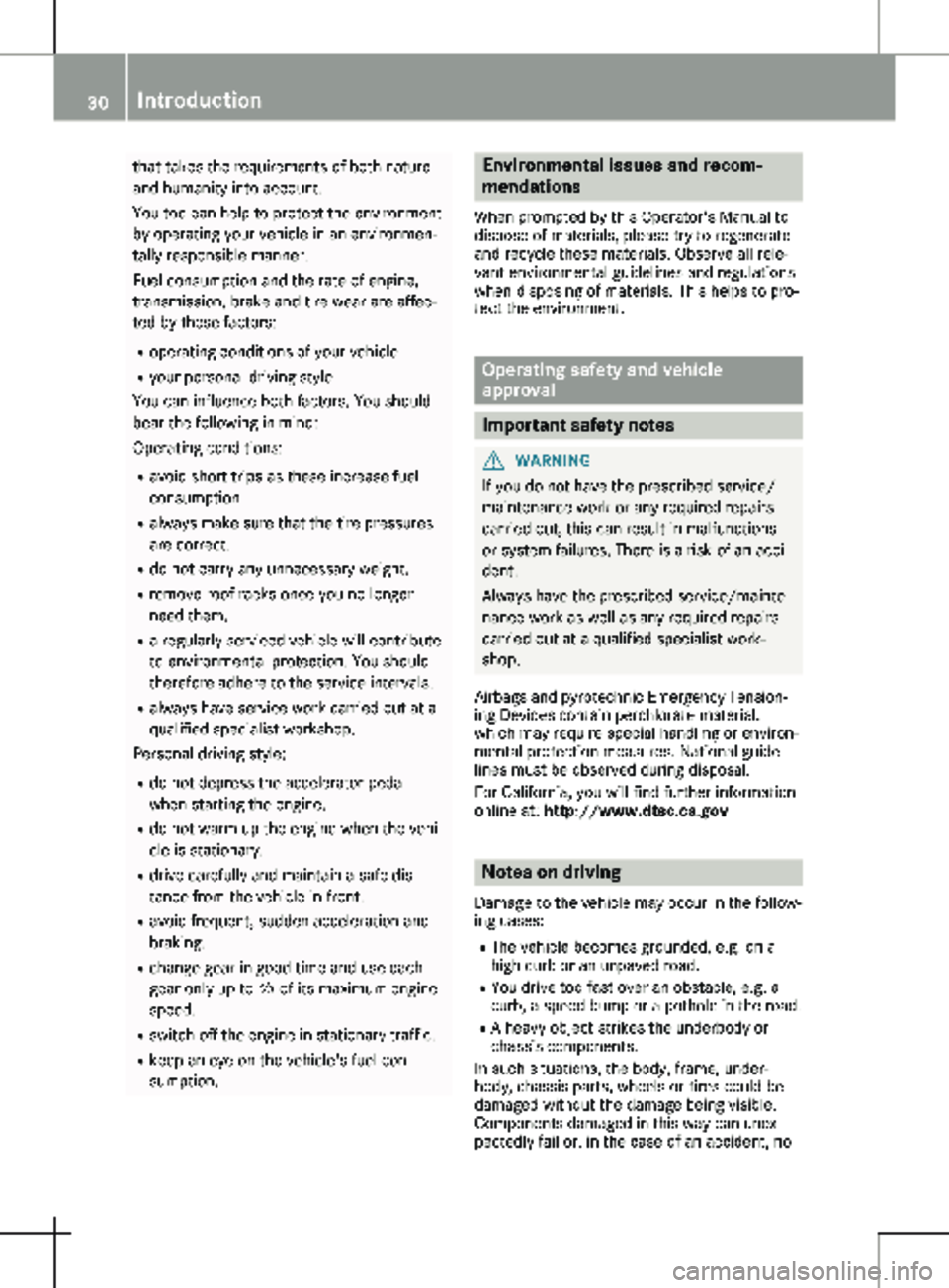
that takes the requirements of both nature
and humanity into account.
You too can help to protect the environment
by operating your vehicle in an environmen-
tally responsible manner.
Fuel consumption and the rate of engine,
transmission, brake and tire wear are affec-
ted by these factors:
R operating conditions of your vehicle
R your personal driving style
You can influence both factors. You should
bear the following in mind:
Operating conditions:
R avoid short trips as these increase fuel
consumption.
R always make sure that the tire pressures
are correct.
R do not carry any unnecessary weight.
R remove roof racks once you no longer
need them.
R a regularly serviced vehicle will contribute
to environmental protection. You should
therefore adhere to the service intervals.
R always have service work carried out at a
qualified specialist workshop.
Personal driving style:
R do not depress the accelerator pedal
when starting the engine.
R do not warm up the engine when the vehi-
cle is stationary.
R drive carefully and maintain a safe dis-
tance from the vehicle in front.
R avoid frequent, sudden acceleration and
braking.
R change gear in good time and use each
gear only up to Ô of its maximum engine
speed.
R switch off the engine in stationary traffic.
R keep an eye on the vehicle's fuel con-
sumption. Environmental issues and recom-
mendations
When prompted by this Operator's Manual to
dispose of materials, please try to regenerate
and recycle these materials. Observe all rele-
vant environmental guidelines and regulations
when disposing of materials. This helps to pro-
tect the environment. Operating safety and vehicle
approval
Important safety notes
G
WARNING
If you do not have the prescribed service/
maintenance work or any required repairs
carried out, this can result in malfunctions
or system failures. There is a risk of an acci-
dent.
Always have the prescribed service/mainte-
nance work as well as any required repairs
carried out at a qualified specialist work-
shop.
Airbags and pyrotechnic Emergency Tension-
ing Devices contain perchlorate material,
which may require special handling or environ-
mental protection measures. National guide-
lines must be observed during disposal.
For California, you will find further information
online at: http://www.dtsc.ca.gov Notes on driving
Damage to the vehicle may occur in the follow-
ing cases:
R The vehicle becomes grounded, e.g. on a
high curb or an unpaved road.
R You drive too fast over an obstacle, e.g. a
curb, a speed bump or a pothole in the road.
R A heavy object strikes the underbody or
chassis components.
In such situations, the body, frame, under-
body, chassis parts, wheels or tires could be
damaged without the damage being visible.
Components damaged in this way can unex-
pectedly fail or, in the case of an accident, no 30
Introduction
Page 55 of 320

tion of the occupant classification system
(OCS) could be adversely affected. This
poses an increased risk of injury or even
fatal injury.
You should only use seat covers that have
been approved for the respective seat by
Mercedes-Benz.
Side impact air bags
: deploy next to the
outer bolster of the seat backrest.
When deployed, the side impact air bag offers
additional thorax and pelvis protection. How-
ever, it does not protect the:
R head
R neck
R arms
If the restraint system control unit detects a
side impact, the side impact air bag is
deployed on the side on which the impact
occurs.
The side impact air bag on the front passenger
side deploys under the following conditions:
R the OCS system detects that the front
passenger seat is occupied or
R the seat belt buckle tongue is engaged in
the belt buckle of the front passenger seat
If the belt tongue is engaged in the belt
buckle, the side impact air bag on the front
passenger side deploys if an appropriate acci-
dent situation occurs. In this case, deployment
is independent of whether the front passenger
seat is occupied or not. Window curtain air bags
Example: window curtain air bag above the front
door
Example: window curtain air bag for all seat rows
Window curtain air bags : or ; are integra-
ted into the side of the roof frame. Window
curtain air bags for all seat rows ; deploy in
the area extending from the front door (A-pil-
lar) to the rear side window (D-pillar).
When deployed, the window curtain air bag
enhances the level of protection for the head.
However, it does not protect the chest or
arms.
If the restraint system control unit detects a
side impact, the window curtain air bag is
deployed on the side on which the impact
occurs.
If the system determines that they can offer
additional protection to that provided by the
seat belt, a window curtain air bag may be
deployed in other accident situations
(Y page
58). Occupant safety
53
Safety Z
Page 56 of 320

Occupant Classification System
(OCS)
Introduction The Occupant Classification System (OCS) cat-
egorizes the person in the front-passenger
seat. Depending on that result, the front-
passenger front air bag is either enabled or
deactivated.
The system does not deactivate:
R the side impact air bag
R the window curtain air bag
R the Emergency Tensioning Devices
Conditions To be classified correctly, the front passenger
must sit:
R with the seat belt fastened correctly
R in an almost upright position with their back
against the seat backrest
R with their feet resting on the floor, if possi-
ble
If the front passenger does not observe these
conditions, OCS may produce a false classifi-
cation, e.g. because the front passenger:
R transfers their weight by supporting them-
selves on a vehicle armrest
R sits in such a way that their weight is raised
from the seat cushion
If it is absolutely necessary to install a child
restraint system on the front-passenger seat,
be sure to observe the correct positioning of
the child restraint system. Never place objects
under or behind the child restraint system, e.g.
a cushion. The entire base of the child
restraint system must always rest on the seat
cushion of the front-passenger seat. The back-
rest of the forward-facing child restraint sys-
tem must lie as flat as possible against the
backrest of the front-passenger seat.
The child restraint system must not touch the
roof or be subjected to a load by the head
restraint. Adjust the angle of the seat backrest
and the head restraint position accordingly.
Only then can OCS be guaranteed to function
correctly. Always observe the child restraint
system manufacturer's installation and operat-
ing instructions. Occupant Classification System (OCS)
operation
PASSENGER AIR BAG OFF indicator lamp
:
shows you whether the front-passenger front
air bag is deactivated.
X Turn the SmartKey to position 1 or 2 in
the ignition lock.
The system carries out self-diagnostics.
The PASSENGER AIR BAG OFF indicator lamp
must light up for approximately six seconds.
The PASSENGER AIR BAG OFF indicator lamp
then displays the status of the front-passenger
front air bag. If the status of the front-
passenger front air bag changes while the
vehicle is in motion, an air bag display mes-
sage may appear on the instrument cluster: R in vehicles without steering wheel buttons
(Y page
197)
R in vehicles with steering wheel buttons
(Y page 211)
When the front-passenger seat is occupied,
always pay attention to the PASSENGER AIR
BAG OFF indicator lamp. Be aware of the sta-
tus of the front-passenger front air bag both
before and during the journey.
If the PASSENGER AIR BAG OFF indicator
lamp:
R lights up, the front-passenger front air bag
is deactivated. It will then not be deployed
in the event of an accident.
R is not it , the front-passenger front air bag is
enabled. If, in the event of an accident, all
deployment criteria are met, the front-
passenger front air bag is deployed. G
WARNING
If the PASSENGER AIR BAG OFF indicator
lamp is lit, the front-passenger front air bag 54
Occupant safety
Safety
Page 66 of 320
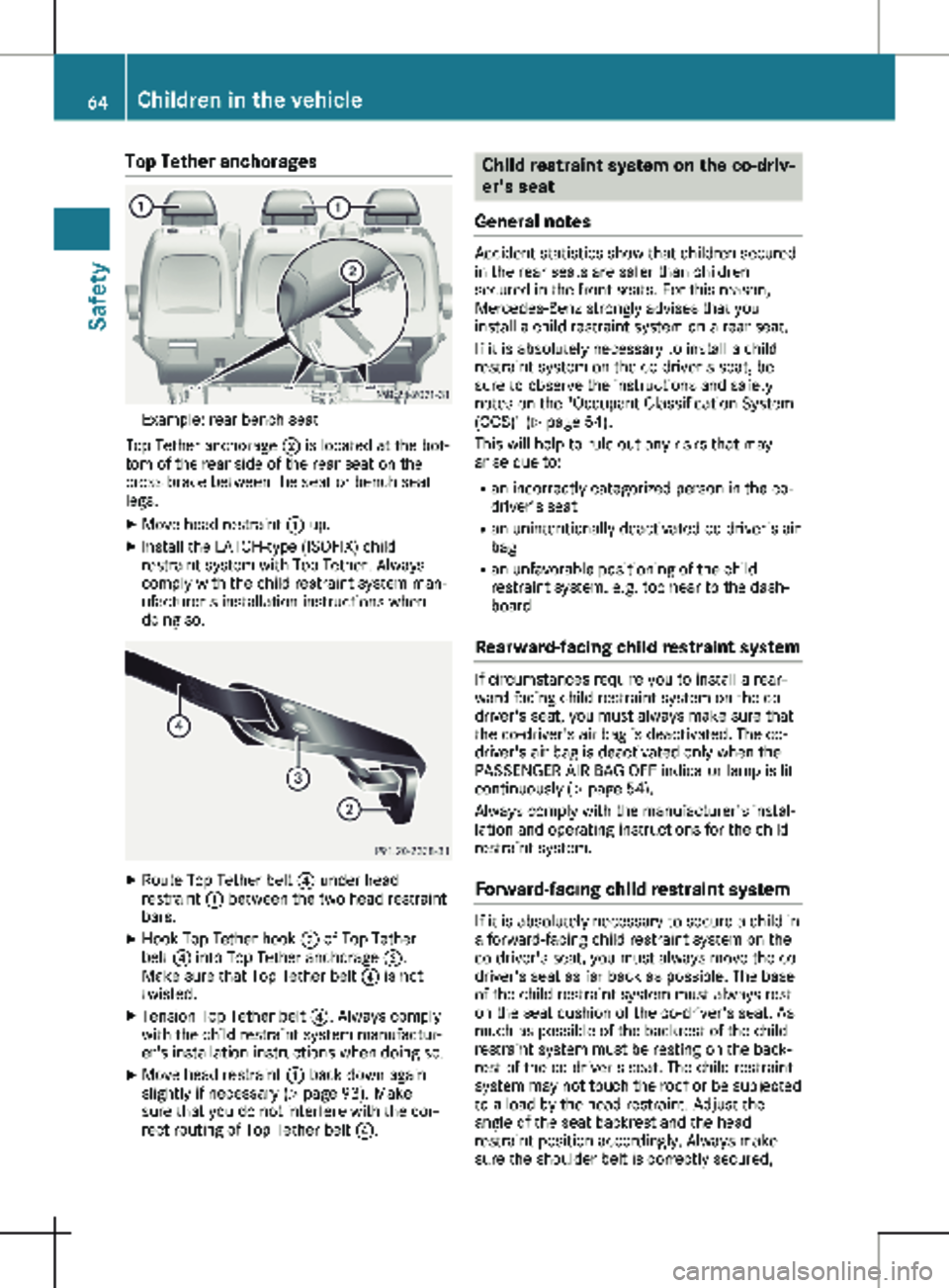
Top Tether anchorages
Example: rear bench seat
Top Tether anchorage ; is located at the bot-
tom of the rear side of the rear seat on the
cross brace between the seat or bench seat
legs.
X Move head restraint : up.
X Install the LATCH-type (ISOFIX) child
restraint system with Top Tether. Always
comply with the child restraint system man-
ufacturer's installation instructions when
doing so. X
Route Top Tether belt ? under head
restraint : between the two head restraint
bars.
X Hook Top Tether hook = of Top Tether
belt ? into Top Tether anchorage ;.
Make sure that Top Tether belt ? is not
twisted.
X Tension Top Tether belt ?. Always comply
with the child restraint system manufactur-
er's installation instructions when doing so.
X Move head restraint : back down again
slightly if necessary (Y page 93). Make
sure that you do not interfere with the cor-
rect routing of Top Tether belt ?. Child restraint system on the co-driv-
er's seat
General notes Accident statistics show that children secured
in the rear seats are safer than children
secured in the front seats. For this reason,
Mercedes-Benz strongly advises that you
install a child restraint system on a rear seat.
If it is absolutely necessary to install a child
restraint system on the co-driver's seat, be
sure to observe the instructions and safety
notes on the "Occupant Classification System
(OCS)"
(Y page 54).
This will help to rule out any risks that may
arise due to:
R an incorrectly categorized person in the co-
driver's seat
R an unintentionally deactivated co-driver's air
bag
R an unfavorable positioning of the child
restraint system, e.g. too near to the dash-
board
Rearward-facing child restraint system If circumstances require you to install a rear-
ward-facing child restraint system on the co-
driver's seat, you must always make sure that
the co-driver's air bag is deactivated. The co-
driver's air bag is deactivated only when the
PASSENGER AIR BAG OFF indicator lamp is lit
continuously ( Y page
54).
Always comply with the manufacturer's instal-
lation and operating instructions for the child
restraint system.
Forward-facing child restraint system If it is absolutely necessary to secure a child in
a forward-facing child restraint system on the
co-driver's seat, you must always move the co-
driver's seat as far back as possible. The base
of the child restraint system must always rest
on the seat cushion of the co-driver's seat. As
much as possible of the backrest of the child
restraint system must be resting on the back-
rest of the co-driver's seat. The child restraint
system may not touch the roof or be subjected
to a load by the head restraint. Adjust the
angle of the seat backrest and the head
restraint position accordingly. Always make
sure the shoulder belt is correctly secured,64
Children in the vehicle
Safety
Page 67 of 320
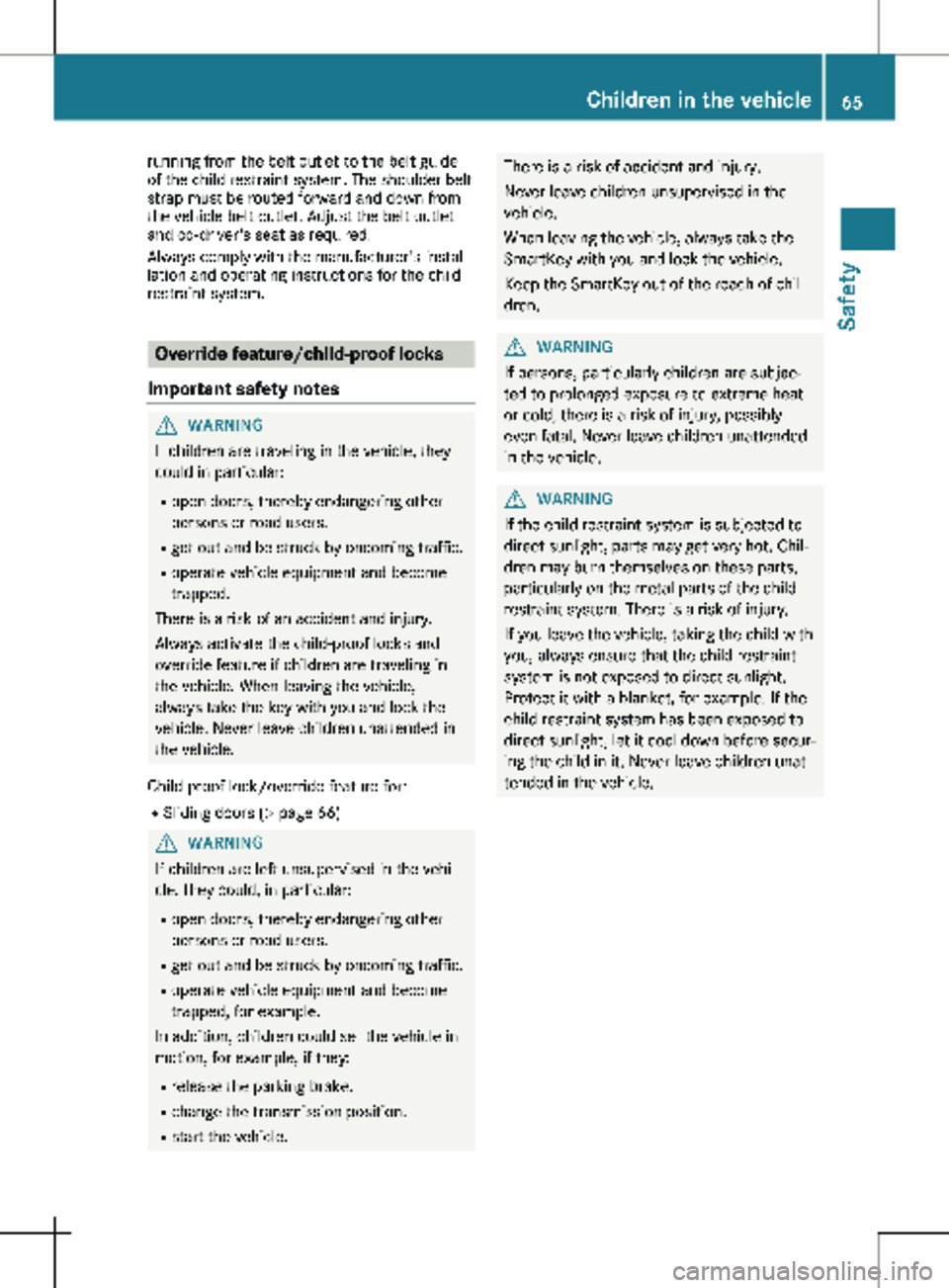
running from the belt outlet to the belt guide
of the child restraint system. The shoulder belt
strap must be routed forward and down from
the vehicle belt outlet. Adjust the belt outlet
and co-driver's seat as required.
Always comply with the manufacturer's instal-
lation and operating instructions for the child
restraint system. Override feature/child-proof locks
Important safety notes G
WARNING
If children are traveling in the vehicle, they
could in particular:
R open doors, thereby endangering other
persons or road users.
R get out and be struck by oncoming traffic.
R operate vehicle equipment and become
trapped.
There is a risk of an accident and injury.
Always activate the child-proof locks and
override feature if children are traveling in
the vehicle. When leaving the vehicle,
always take the key with you and lock the
vehicle. Never leave children unattended in
the vehicle.
Child-proof lock/override feature for:
R Sliding doors ( Y page
66)G
WARNING
If children are left unsupervised in the vehi-
cle, they could, in particular:
R open doors, thereby endangering other
persons or road users.
R get out and be struck by oncoming traffic.
R operate vehicle equipment and become
trapped, for example.
In addition, children could set the vehicle in
motion, for example, if they:
R release the parking brake.
R change the transmission position.
R start the vehicle. There is a risk of accident and injury.
Never leave children unsupervised in the
vehicle.
When leaving the vehicle, always take the
SmartKey with you and lock the vehicle.
Keep the SmartKey out of the reach of chil-
dren.
G
WARNING
If persons, particularly children are subjec-
ted to prolonged exposure to extreme heat
or cold, there is a risk of injury, possibly
even fatal. Never leave children unattended
in the vehicle. G
WARNING
If the child restraint system is subjected to
direct sunlight, parts may get very hot. Chil-
dren may burn themselves on these parts,
particularly on the metal parts of the child
restraint system. There is a risk of injury.
If you leave the vehicle, taking the child with
you, always ensure that the child restraint
system is not exposed to direct sunlight.
Protect it with a blanket, for example. If the
child restraint system has been exposed to
direct sunlight, let it cool down before secur-
ing the child in it. Never leave children unat-
tended in the vehicle. Children in the vehicle
65
Safety Z